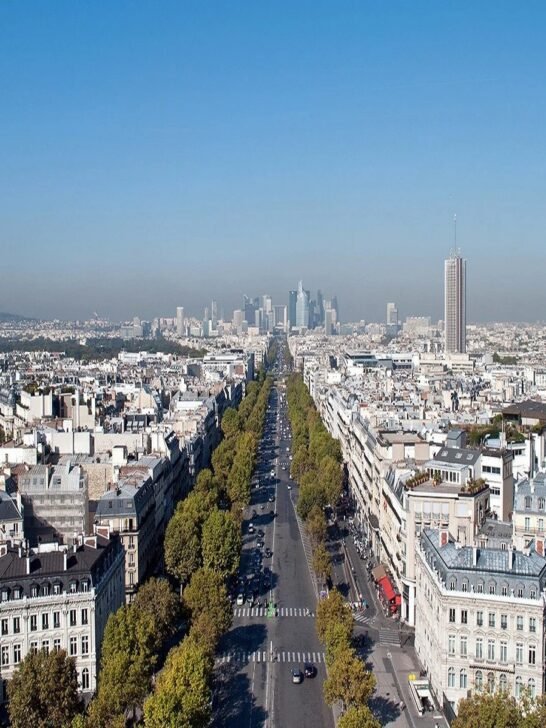Paris, the City of Light, is home to some of the most breathtaking viewpoints in the world. Whether you're looking for a panoramic cityscape, a romantic sunset, or a unique perspective of the Eiffel Tower, Paris offers countless vantage points to take in its beauty. Here are some of the best places to enjoy the most stunning views of the French capital.
Best Viewpoints in Paris
Table Of Content
This blog contains affiliate links, which means I may earn a commission if you make a purchase through these links, at no additional cost to you.
1. Eiffel Tower
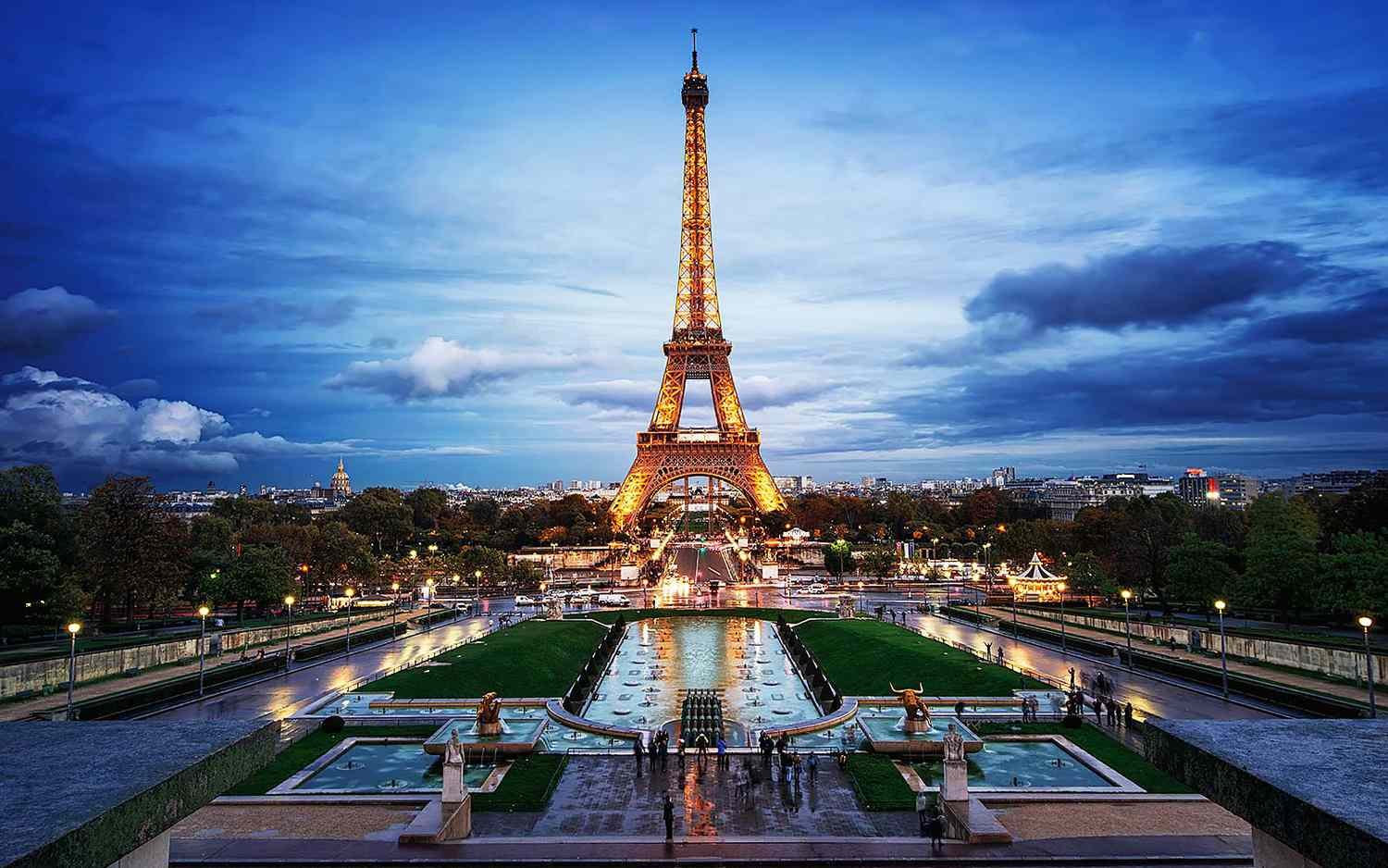
No list of viewpoints in Paris would be complete without mentioning the Eiffel Tower. As the city's most iconic landmark, its observation decks provide an unparalleled view of Paris from different heights. The summit, at 276 meters, offers a breathtaking 360-degree panorama that showcases the Seine River, historic monuments, and the charming rooftops of the city.
Few landmarks in the world are as instantly recognizable and beloved as the Eiffel Tower. Standing majestically over the Parisian skyline, this architectural masterpiece attracts millions of visitors each year. Whether you’re a first-time traveler or a returning admirer, the Eiffel Tower offers a captivating experience that embodies the essence of Paris.
A Brief History
Designed by Gustave Eiffel and completed in 1889 for the Exposition Universelle (World’s Fair), the Eiffel Tower was initially met with skepticism by critics. However, over the years, it has become a global symbol of elegance, innovation, and romance. Originally intended to be a temporary structure, it was preserved due to its value as a radio transmission tower, eventually securing its place as a permanent Parisian icon.
Architectural Marvel
The Eiffel Tower stands at 330 meters (1,083 feet) tall and consists of 18,038 iron parts, carefully assembled to create its striking lattice structure. Its engineering brilliance was revolutionary at the time and remains a testament to 19th-century craftsmanship. The tower’s unique design allows it to expand and contract slightly depending on temperature changes, demonstrating its remarkable structural adaptability.
Visitor Experience
Exploring the Eiffel Tower is an unforgettable experience, offering different perspectives of Paris from its various levels:
- First Floor: Featuring a glass floor, interactive exhibits, and the 58 Tour Eiffel restaurant, this level provides an immersive introduction to the tower’s history.
- Second Floor: Known for its breathtaking views, this level allows visitors to see Parisian landmarks such as the Seine River, Notre-Dame Cathedral, and the Arc de Triomphe with greater clarity. It also houses the Michelin-starred restaurant Le Jules Verne.
- Summit: At 276 meters (905 feet), the summit offers a panoramic view of Paris, an intimate look at Gustave Eiffel’s private office, and a champagne bar to celebrate the moment.
Best Times to Visit
To avoid large crowds, consider visiting early in the morning or late in the evening. The tower is particularly enchanting at night when it is illuminated by 20,000 golden lights, creating a magical atmosphere. The sparkling light show, which occurs every hour after sunset, is a must-see spectacle.
Discover unbeatable hotel deals for your next adventure—compare prices and book your perfect stay effortlessly on our platform today!
Interesting Facts
- The Eiffel Tower was the tallest structure in the world until the completion of the Chrysler Building in New York in 1930.
- During World War II, the tower’s elevators were disabled to prevent enemy forces from using them.
- The tower is repainted every seven years with 60 tons of paint to protect it from rust and maintain its beauty.
2. Montparnasse Tower
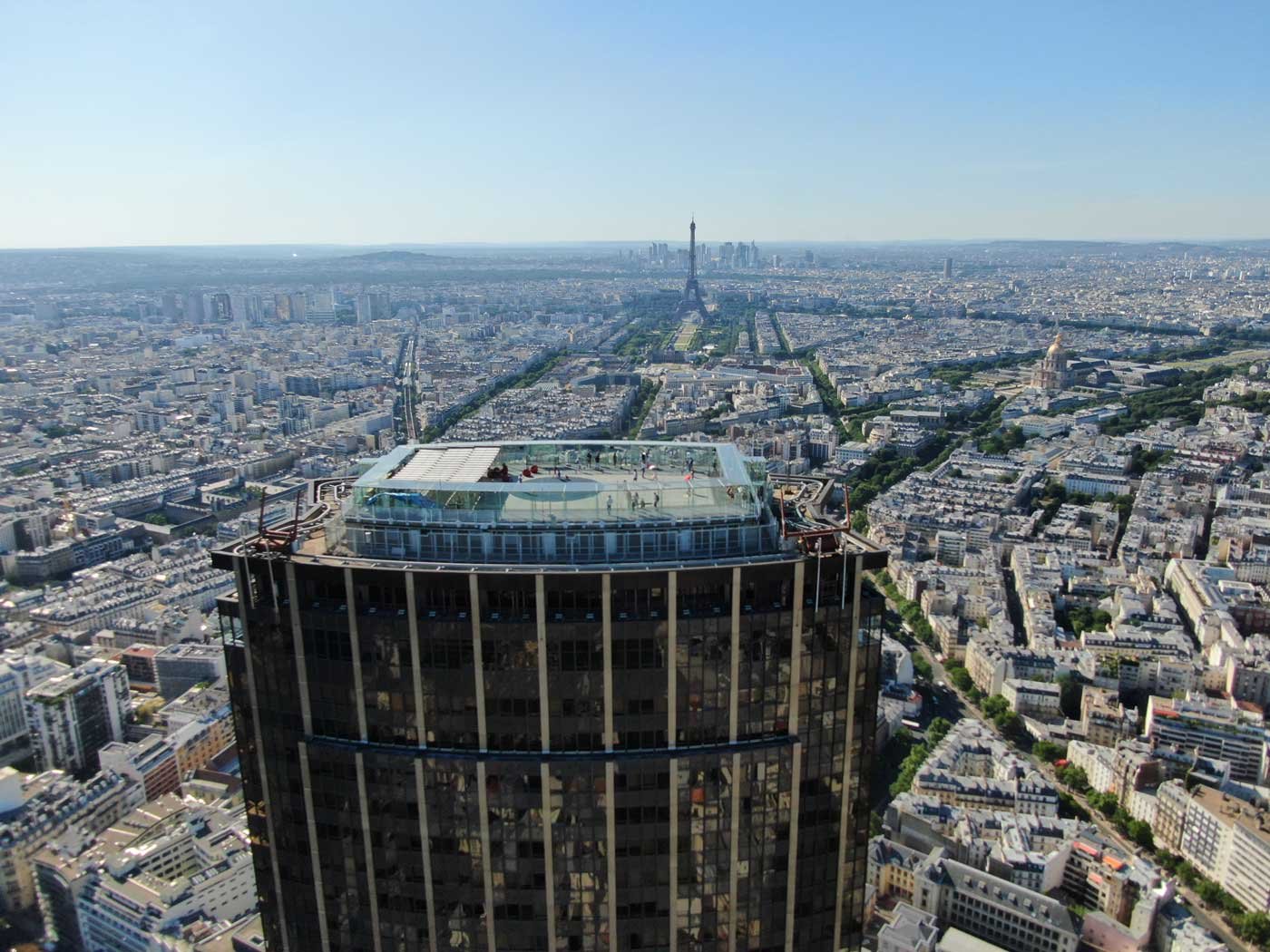
For those who want to admire the Paris skyline with the Eiffel Tower in it, Montparnasse Tower is the perfect choice. Its 56th-floor observation deck provides one of the most striking cityscapes, especially at sunset when the city lights start to twinkle.
When searching for the best panoramic view of Paris, many people instinctively think of the Eiffel Tower. However, for an unparalleled view including the Eiffel Tower itself, Montparnasse Tower is the ultimate vantage point. As one of the tallest buildings in the city, it offers breathtaking 360-degree views of the French capital, making it a must-visit destination for tourists and photography enthusiasts alike.
A Brief History
Montparnasse Tower, also known as Tour Montparnasse, was completed in 1973 and stands at 210 meters (689 feet). It was Paris’s first skyscraper and remains one of the most distinctive buildings in the city. While its modern glass-and-steel design initially sparked controversy among Parisians, its observation deck has since become one of the best spots to admire the beauty of the city from above.
Why Visit Montparnasse Tower?
Unlike other viewpoints in Paris, Montparnasse Tower offers a more relaxed and comfortable experience with significantly shorter waiting times. Here’s what makes it special:
- Unobstructed Panoramic Views: From the 56th floor and the open-air rooftop terrace, visitors can enjoy a breathtaking view of Paris, featuring landmarks like the Eiffel Tower, Notre-Dame Cathedral, the Louvre, and the Seine River.
- Less Crowded Experience: Unlike the Eiffel Tower, Montparnasse Tower offers a quieter, less hectic experience, allowing visitors to take in the view without the long lines and crowds.
- A Stunning Sunset Spot: One of the best times to visit Montparnasse Tower is at sunset, when the cityscape transforms into a golden masterpiece and the Eiffel Tower begins to sparkle.
- Indoor and Outdoor Viewing Areas: The 56th floor offers a comfortable indoor viewing area with interactive exhibits and a café, while the rooftop terrace provides an open-air experience for the best photographic opportunities.
Best Time to Visit
The Montparnasse Tower observation deck is open year-round, but the best times to visit are during sunset or in the evening when Paris is illuminated. The view at night, with the Eiffel Tower glowing and the city lights twinkling, is a truly magical sight.
Find the best hotel deals for your next trip—compare prices from top sites and book your perfect stay all in one place!
Interesting Facts
- Montparnasse Tower was once the tallest building in France until it was surpassed by Tour First in La Défense.
- The elevator to the observation deck is one of the fastest in Europe, reaching the 56th floor in just 38 seconds.
- The rooftop terrace is often used for special events, including film screenings and private gatherings.
3. Sacré-Cœur Basilica (Montmartre)

Perched on the highest natural point in Paris, the dome of Sacré-Cœur Basilica in Montmartre offers a mesmerizing view of the city. The climb up the narrow spiral staircase is well worth the effort, rewarding visitors with a picturesque vista of Paris stretching out beneath them.
Perched atop the highest point in Paris, the Sacré-Cœur Basilica stands as one of the most iconic landmarks of the French capital. Overlooking the vibrant Montmartre district, this magnificent basilica offers not only a spiritual sanctuary but also one of the most breathtaking panoramic views of the city. A visit to Sacré-Cœur is an essential experience for those who wish to immerse themselves in the history, culture, and charm of Paris.
A Brief History
The Sacré-Cœur Basilica, meaning “Sacred Heart,” was built as a symbol of national unity and faith. Its construction began in 1875, following the Franco-Prussian War, and was completed in 1914. Designed by architect Paul Abadie, the basilica was consecrated in 1919 and has since become a revered place of worship and a significant cultural landmark.
Architectural Beauty
The basilica’s Romano-Byzantine design is a striking contrast to the Gothic architecture seen in other famous Parisian churches, such as Notre-Dame. Its gleaming white façade is made from Château-Landon stone, which naturally whitens over time due to its reaction with rainwater. The grand central dome, flanked by two smaller domes, and the 83-meter bell tower contribute to the basilica’s distinctive silhouette.
Inside, visitors are greeted by the stunning mosaic of Christ in Majesty, one of the largest mosaics in the world. The basilica’s vast interior, with its golden accents and peaceful ambiance, provides a space for reflection and reverence.
The Best View of Paris
Sacré-Cœur offers one of the most spectacular viewpoints in Paris. From its terrace, visitors can enjoy sweeping views of the city’s rooftops, with landmarks like the Eiffel Tower and the Seine River visible in the distance. For an even higher vantage point, climbing the 300 steps to the basilica’s dome rewards visitors with an unparalleled 360-degree view of Paris.
Montmartre: A Neighborhood of Art and History
Beyond the basilica itself, Montmartre is a neighborhood steeped in artistic heritage. Once home to legendary artists like Picasso, Van Gogh, and Toulouse-Lautrec, its cobblestone streets, charming cafés, and lively squares continue to attract creatives and visitors alike. The nearby Place du Tertre, where artists display their works, embodies the artistic spirit of Montmartre.
Best Times to Visit
To fully appreciate the beauty of Sacré-Cœur, consider visiting early in the morning or at sunset, when the light bathes the basilica in a warm glow. The basilica is open daily, and admission is free, though there is a small fee to access the dome.
Find the best hotel deals for your next trip—compare prices across top travel sites and book your ideal stay instantly on [travelbloger.net]!
Interesting Facts
- Sacré-Cœur houses the Savoyarde Bell, one of the heaviest bells in the world, weighing 19 tons.
- The basilica has had continuous prayer and adoration since 1885, making it a significant spiritual site.
- The white stone used for its construction ensures that Sacré-Cœur remains luminous despite the passage of time.
4. Arc de Triomphe
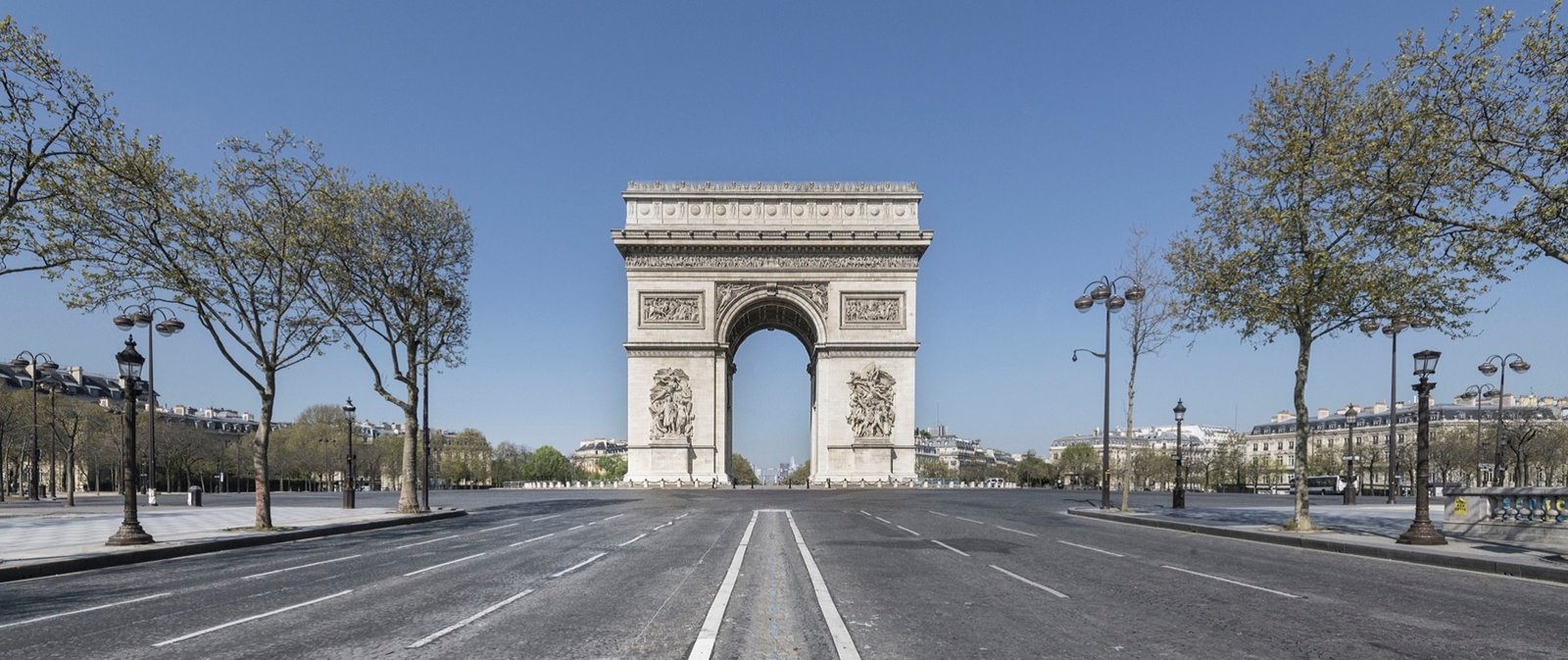
Located at the western end of the Champs-Élysées, the Arc de Triomphe provides a unique viewpoint over the bustling avenue and beyond. From the top, you can witness the symmetrical streets radiating outward, forming the famous Étoile (star) pattern, with the Eiffel Tower standing proudly in the distance.
Standing majestically at the western end of the Champs-Élysées, the Arc de Triomphe is one of the most significant and awe-inspiring landmarks in Paris. This monumental structure not only embodies French national pride but also serves as a powerful tribute to the country’s military history. A visit to the Arc de Triomphe is an essential experience for anyone looking to explore the rich heritage of France.
A Brief History
Commissioned by Emperor Napoleon Bonaparte in 1806, the Arc de Triomphe was designed to honor the victories of the French army. Inspired by the great Roman arches, its construction was completed in 1836 under King Louis-Philippe. Since then, it has stood as a symbol of unity, resilience, and military glory.
The Arc de Triomphe has witnessed some of France’s most defining historical moments, including the return of Napoleon’s remains in 1840 and victory parades after both World Wars. Today, it continues to serve as a site of national remembrance, hosting ceremonies such as the annual commemoration of Armistice Day.
Architectural Grandeur
Designed by architect Jean Chalgrin, the Arc de Triomphe stands 50 meters (164 feet) high and 45 meters (148 feet) wide. The monument is adorned with intricate sculptures, each depicting important moments in French military history. The most famous reliefs include:
- Le Départ des Volontaires (The Departure of the Volunteers) by François Rude, also known as La Marseillaise, symbolizing the patriotic spirit of the French Revolution.
- Le Triomphe de 1810 (The Triumph of 1810) by Jean-Pierre Cortot, celebrating Napoleon’s military victories.
- La Résistance de 1814 (The Resistance of 1814) and La Paix de 1815 (The Peace of 1815), commemorating France’s resilience in battle.
Beneath the arch lies the Tomb of the Unknown Soldier, added in 1921 as a tribute to the unidentified soldiers who perished during World War I. An eternal flame burns in their memory, rekindled every evening at 6:30 PM.
A Panoramic View of Paris
Visitors who ascend the 284 steps to the Arc de Triomphe’s rooftop are rewarded with one of the most breathtaking views of Paris. From this vantage point, the city's symmetrical avenues radiate outward in a star-shaped pattern, a design that gives the surrounding area its name: Place de l’Étoile. The rooftop provides a stunning perspective of the Eiffel Tower, the Champs-Élysées, and La Défense, making it one of the best photo spots in the city.
Best Times to Visit
To avoid crowds and fully appreciate the monument’s grandeur, consider visiting early in the morning or at sunset. The evening offers a particularly magical experience as Paris lights up, and the illuminated Eiffel Tower glows in the distance.
Looking for budget-friendly flights or all-in-one travel packages? Check out our top picks and start planning your perfect getaway today!
Interesting Facts
- The Arc de Triomphe is the second-largest triumphal arch in the world, after the Monumento a la Revolución in Mexico City.
- Napoleon never saw its completion; he died in 1821, 15 years before the monument was finished.
- In 1919, Charles Godefroy famously flew a biplane through the arch to celebrate the end of World War I.
5. Galeries Lafayette Rooftop Terrace
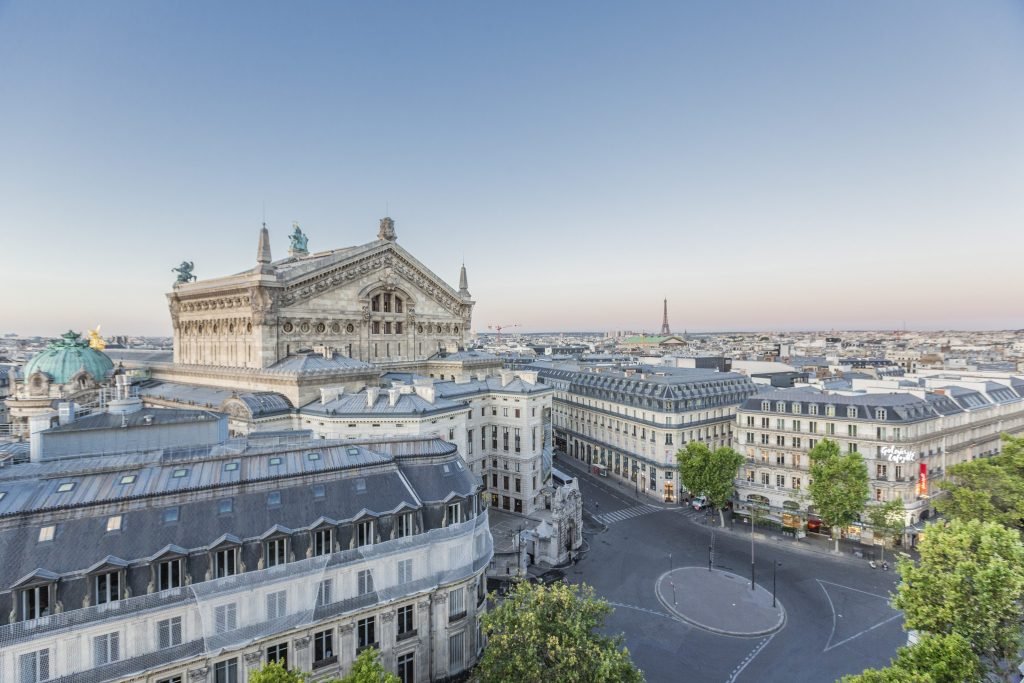
For a free and stunning viewpoint in the heart of the city, head to the rooftop terrace of Galeries Lafayette. Overlooking the Opéra Garnier, this terrace offers a sweeping view of central Paris, including a unique angle of the Eiffel Tower.
Paris is a city known for its breathtaking views, and while landmarks like the Eiffel Tower and Montparnasse Tower offer famous vantage points, few spots provide a more elegant and accessible experience than the Galeries Lafayette Rooftop Terrace. Located atop the iconic Galeries Lafayette Haussmann department store, this hidden gem offers visitors a spectacular panoramic view of Paris—completely free of charge.
A Unique Viewpoint Over Paris
The Galeries Lafayette Rooftop Terrace is one of the city’s best-kept secrets, offering a 360-degree view of Paris’s most famous landmarks. From this stunning vantage point, visitors can admire:
- The Eiffel Tower, rising majestically over the city skyline.
- The Opéra Garnier, located just a short distance away.
- The iconic Sacré-Cœur Basilica, perched on Montmartre.
- The Seine River and the rooftops of historic Paris.
The terrace features a modern and minimalist design, with ample seating areas that allow visitors to relax and take in the breathtaking scenery. Whether you’re looking to capture the perfect Instagram shot or simply enjoy a peaceful escape from the bustling city streets, this spot is an ideal retreat.
A Historic Shopping Destination
Beyond the terrace, Galeries Lafayette Haussmann is a destination in itself. Founded in 1894, this grand department store is an architectural masterpiece, famous for its stunning Art Nouveau glass dome, which bathes the interior in a golden glow. The store is a paradise for shoppers, offering an array of luxury brands, designer boutiques, and gourmet food experiences.
For those with a passion for fashion, Galeries Lafayette also hosts regular fashion shows, giving visitors a taste of Parisian style and elegance.
Best Time to Visit
The terrace is open year-round and is particularly magical at sunset when the city is bathed in golden hues. Arriving in the late afternoon allows visitors to experience both the daytime views and the spectacular evening transformation of Paris as the city lights begin to twinkle.
Dining with a View
For those who wish to dine with a view, the terrace is home to a rooftop restaurant and bar, offering a selection of gourmet dishes and cocktails. Whether you're sipping a glass of French wine or enjoying a light meal, there’s no better place to soak in the Parisian atmosphere.
Interesting Facts
- Unlike other famous viewpoints in Paris, the Galeries Lafayette Rooftop Terrace is completely free to visit.
- The department store welcomes over 37 million visitors each year, making it one of the most visited shopping destinations in the world.
- The store's Art Nouveau dome is made up of 10 colorful stained-glass panels and stands 43 meters high.
If you're planning a trip or looking for anything travel-related—flights, hotels, tours, or inspiration—be sure to check out these great links for the best options!
6. Parc de Belleville

One of Paris’s lesser-known viewpoints, Parc de Belleville is a hidden gem that provides a more relaxed and local experience. Situated on the city’s eastern heights, this park offers a panoramic view that is especially beautiful at sunset.
A Brief History
Located in the 20th arrondissement, Parc de Belleville was inaugurated in 1988 as part of an urban renewal project. The Belleville neighborhood has long been known for its rich cultural diversity, artistic vibrancy, and working-class roots. Historically, the area was home to vineyards and small farms before transforming into a dynamic hub for artists and immigrants. Today, the park stands as a symbol of the district’s evolving identity, offering locals and visitors a serene green space with a spectacular cityscape backdrop.
What Makes Parc de Belleville Special?
Unlike the more tourist-heavy parks in central Paris, Parc de Belleville provides an authentic and tranquil experience, making it an ideal spot for relaxation, photography, and local exploration. Here’s what makes it unique:
- A Stunning Viewpoint: At 108 meters above sea level, the park’s terrace offers one of the best panoramic views of Paris. Visitors can admire famous landmarks such as the Eiffel Tower, Montmartre, and the rooftops of the city.
- Lush Greenery and Landscaped Gardens: Covering over 45,000 square meters, the park is filled with diverse plant species, winding pathways, and vibrant flower beds, making it a picturesque setting for a leisurely stroll.
- A Hidden Vineyard: As a nod to Belleville’s history, the park features a small urban vineyard, preserving the area’s winemaking heritage.
- Water Features and Play Areas: A beautiful cascading fountain flows down the slopes of the park, adding a soothing ambiance. Families will also appreciate the well-equipped children’s playground, making it a great spot for visitors of all ages.
- Street Art and Cultural Atmosphere: The surrounding Belleville district is a renowned hub for street art, and visitors can find impressive murals near the park that showcase the neighborhood’s artistic spirit.
Best Times to Visit
Parc de Belleville is enjoyable year-round, but the best times to visit are during the spring and summer months, when the flowers are in full bloom, and the greenery is at its most vibrant. For photographers and sunset lovers, arriving in the late afternoon allows you to witness the sun setting over the Paris skyline, creating a magical golden-hour experience.
Interesting Facts
- Parc de Belleville is home to the Maison de l’Air, a small museum dedicated to air quality and environmental awareness.
- The park sits in one of the most culturally diverse districts of Paris, offering a mix of French, Asian, and North African influences.
- The Belleville neighborhood was once home to famous French singers Édith Piaf and Maurice Chevalier.
If you're looking to book a fantastic holiday or find the perfect accommodation, simply use these trusted links to get started with ease and confidence.
7. Institute du Monde Arabe
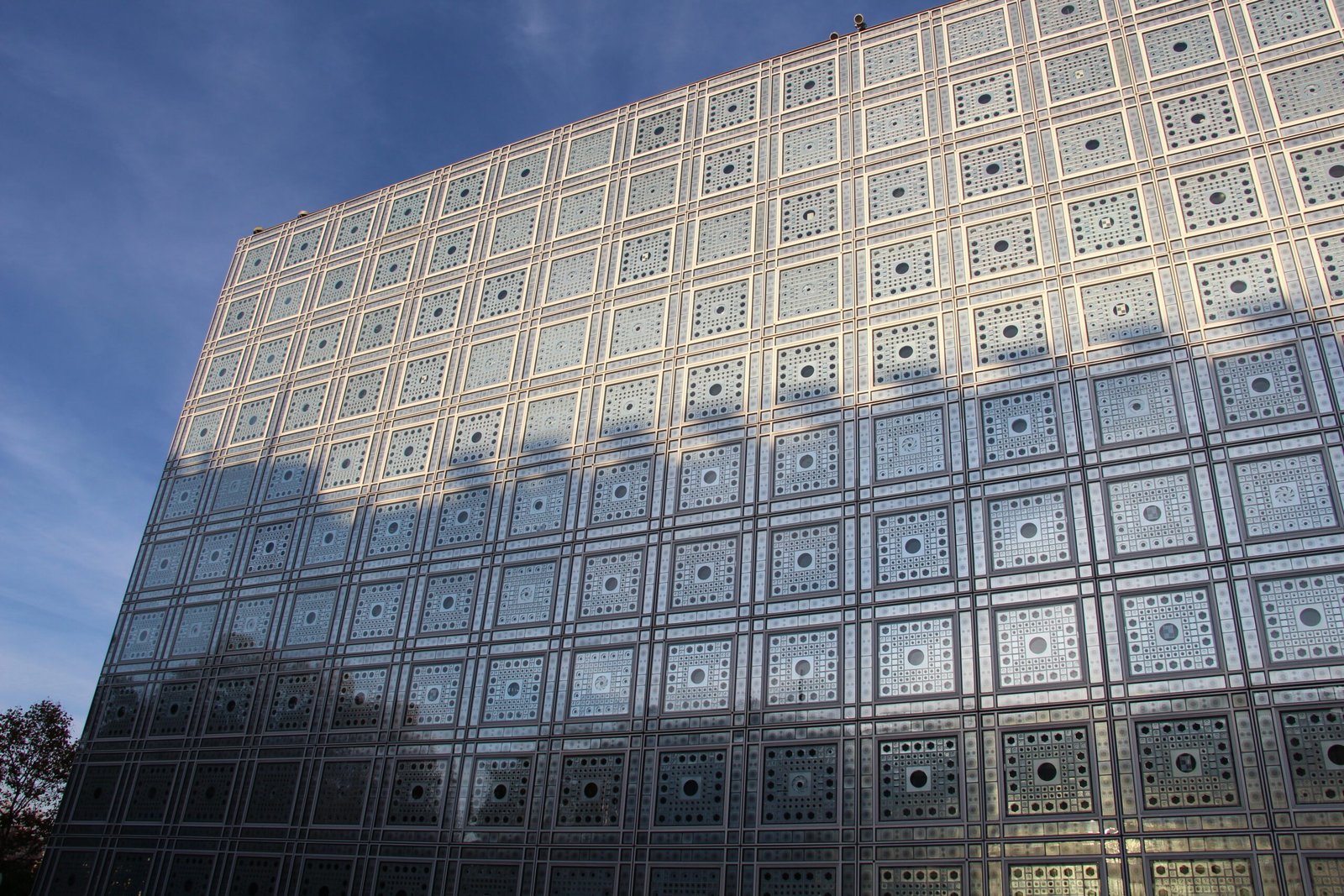
If you're looking for a distinctive view of the Seine River and Notre-Dame Cathedral, the rooftop of the Institute du Monde Arabe is an excellent choice. The terrace is free to access and provides an elegant perspective of the city’s historic center.
Located on the banks of the Seine in the heart of Paris, the Institut du Monde Arabe (IMA) stands as a beacon of cultural exchange, celebrating the rich heritage of the Arab world. Designed by the renowned architect Jean Nouvel, this architectural masterpiece seamlessly blends tradition and modernity while serving as an essential hub for promoting Arab art, history, and innovation. Whether you are an art enthusiast, a history buff, or simply a curious traveler, a visit to the Institut du Monde Arabe offers a captivating journey through centuries of Arab culture.
A Visionary Architectural Marvel
Inaugurated in 1987, the Institut du Monde Arabe was conceived as a bridge between France and the Arab world, fostering greater understanding and appreciation of Arab civilization. The building’s most striking feature is its façade of 240 mechanical mashrabiya-inspired panels, which automatically adjust to control the amount of natural light entering the interior. This ingenious design not only pays homage to traditional Arab geometric patterns but also showcases the fusion of heritage and cutting-edge technology.
Exploring the Museum and Exhibitions
The IMA Museum houses an extensive collection of artifacts that span thousands of years, covering the vast geographical expanse of the Arab world—from North Africa to the Middle East. Some of the highlights include:
- Ancient Manuscripts & Calligraphy – Exquisite Qur'anic scripts and medieval texts reflecting the artistry of Arabic writing.
- Islamic Art & Ceramics – Intricately decorated pottery, textiles, and mosaics showcasing the craftsmanship of Arab artisans.
- Contemporary Art Installations – Rotating exhibitions featuring modern Arab artists, offering insights into contemporary social and political themes.
Beyond the museum, the Institut du Monde Arabe frequently hosts temporary exhibitions, film screenings, lectures, and concerts, making it a dynamic cultural venue that stays at the forefront of artistic and intellectual discourse.
The Best Panoramic View of Paris
One of the hidden gems of the Institut du Monde Arabe is its rooftop terrace, offering one of the most breathtaking panoramic views of Paris. From this vantage point, visitors can admire spectacular sights of the Seine, Notre-Dame Cathedral, and the historic Île de la Cité. For an enhanced experience, the rooftop also features a fine-dining restaurant, where guests can savor exquisite Middle Eastern cuisine while enjoying the stunning cityscape.
A Cultural Experience Beyond the Museum
In addition to its museum and exhibitions, the IMA also houses a library, a bookshop, and a research center, making it a key institution for scholars and those interested in Arab literature, philosophy, and history. The auditorium regularly hosts concerts, theater performances, and film festivals that celebrate the diversity of Arab artistic expression.
For a more immersive experience, visitors can explore the Institut’s cultural programs, which include:
- Arabic language courses for all levels, from beginners to advanced learners.
- Lectures and debates featuring prominent intellectuals and artists.
- Seasonal festivals that celebrate Arab music, cinema, and literature.
Best Time to Visit
The Institut du Monde Arabe is open year-round, but the best time to visit is during special exhibitions or cultural events that offer an enriched experience. Whether you explore the museum during the day or visit in the evening to admire the illuminated façade and rooftop view, the IMA guarantees a memorable visit.
Interesting Facts
- The mashrabiya panels on the building’s façade contain light-sensitive diaphragms that open and close, mimicking traditional Arabic window screens.
- The IMA was founded as part of a collaboration between France and 18 Arab nations, aiming to strengthen cultural ties between Europe and the Arab world.
- The library at the IMA is home to over 100,000 books on Arab history, literature, and science.
8. Printemps Haussmann Rooftop
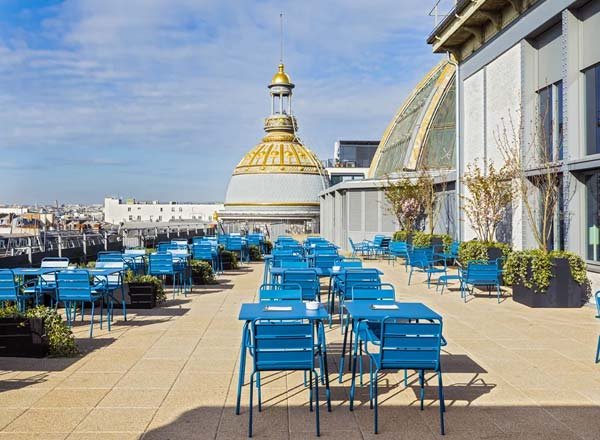
Another fantastic shopping destination with an incredible view, the Printemps department store features a rooftop café where visitors can enjoy a meal while taking in an unobstructed panorama of Paris, including the Eiffel Tower and Montmartre.
A Rooftop with a View Like No Other
Located in the heart of Boulevard Haussmann, the Printemps Haussmann Rooftop offers one of the best 360-degree views of Paris. From this stunning perch, visitors can enjoy a clear, unobstructed perspective of:
- The Eiffel Tower, standing majestically in the distance.
- The Opéra Garnier, just a stone’s throw away.
- The Sacré-Cœur Basilica, rising above Montmartre.
- The intricate rooftops and grand boulevards that define Parisian architecture.
Unlike other popular viewpoints, the Printemps Rooftop remains a relatively peaceful and uncrowded spot, allowing visitors to soak in the beauty of the city at their leisure.
A Blend of History and Elegance
The Printemps Haussmann department store is a Parisian institution, first opened in 1865 and renowned for its stunning Art Nouveau and Art Deco design. Beyond the rooftop terrace, the store itself is worth exploring, featuring a breathtaking stained-glass dome, grand staircases, and an extensive selection of luxury fashion, beauty, and home decor.
Dining with a View: A Unique Experience
The rooftop is home to Déli-Cieux, a stylish café that allows visitors to enjoy light meals, coffee, and refreshing drinks while admiring the cityscape. Whether you’re sipping on a glass of champagne at sunset or enjoying a casual lunch in the afternoon, the atmosphere is nothing short of magical.
For those looking for a more refined dining experience, Printemps also hosts exclusive rooftop pop-up restaurants, offering gourmet cuisine in a chic and intimate setting.
Best Time to Visit
To make the most of your visit, consider stopping by during the late afternoon or sunset, when the golden hues of the setting sun cast a breathtaking glow over the city. The rooftop is open year-round, making it a fantastic destination whether you’re visiting Paris in the summer or during the cozy winter months.
Interesting Facts About Printemps Haussmann Rooftop
- The department store itself is classified as a historic monument, with its glass dome being one of the most impressive features in Parisian retail.
- The rooftop terrace is free to access, making it one of the best cost-free panoramic experiences in the city.
- Printemps Haussmann spans three buildings and over 44,000 square meters, making it one of the largest luxury department stores in Paris.
9. La Défense Grande Arche
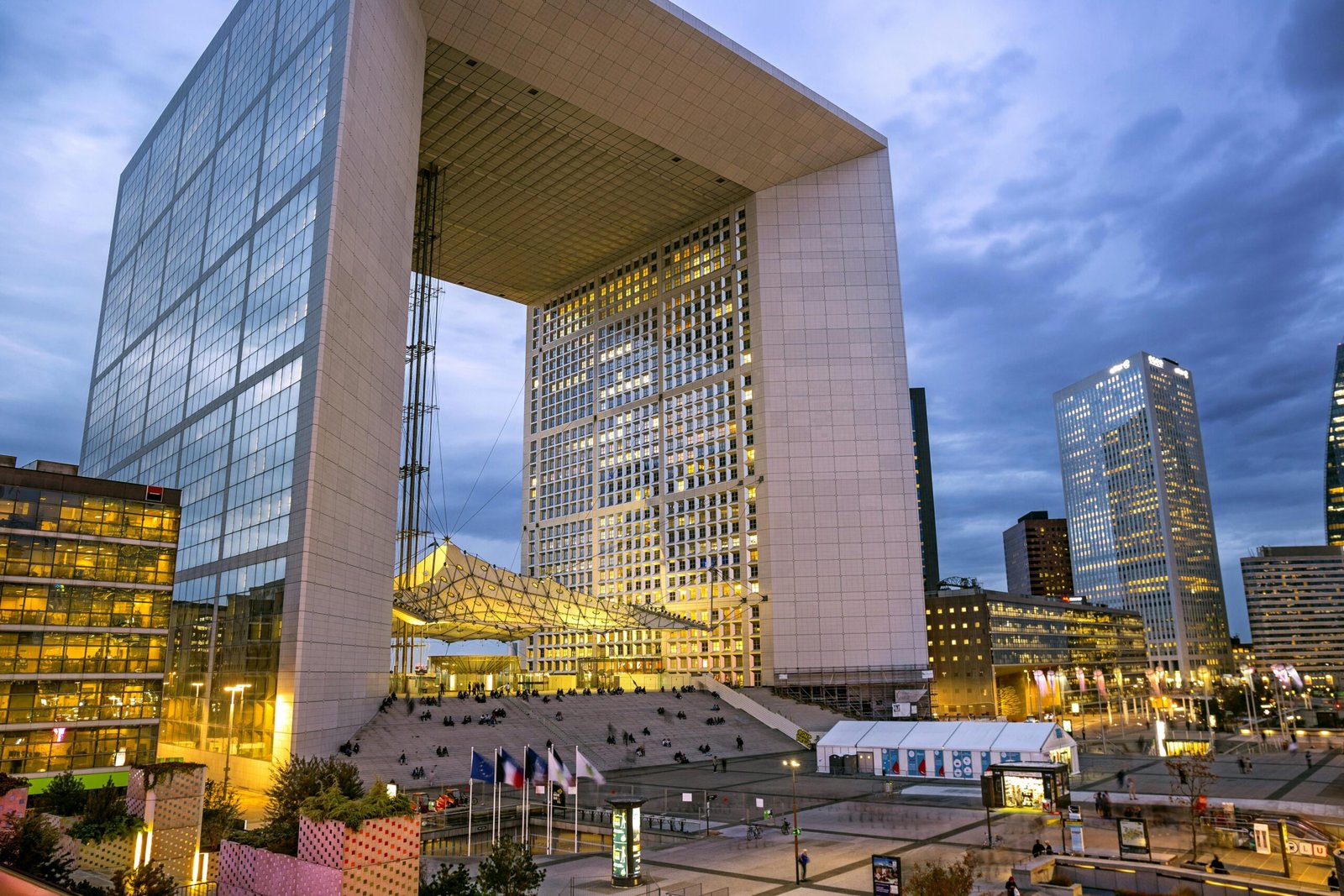
For a more modern take on Paris, head to La Défense, the business district of the city. The Grande Arche offers a dramatic contrast to historic Paris, and its rooftop provides a spectacular line-of-sight view stretching all the way to the Arc de Triomphe and beyond.
While Paris is often celebrated for its historic monuments, charming streets, and classical architecture, the Grande Arche de La Défense stands as a symbol of the city's modern and ambitious spirit. Located in the heart of La Défense, the city's primary business district, this architectural masterpiece is not just an office hub but also a cultural and tourist attraction offering some of the most stunning panoramic views of Paris.
A Visionary Architectural Feat
The Grande Arche, also known as the Grande Arche de la Fraternité, was designed by Danish architect Johann Otto von Spreckelsen and inaugurated in 1989 as a modern reinterpretation of the historic Arc de Triomphe. Unlike its historic counterpart, which symbolizes military victories, the Grande Arche represents peace, humanity, and universal ideals. Standing at 110 meters high, 106 meters wide, and 112 meters deep, its imposing cubic structure is an impressive feat of engineering and design.
The pure white façade, made of Carrara marble and glass, reflects the sunlight beautifully, creating a striking contrast against the steel and glass skyscrapers of La Défense.
A View Like No Other
One of the main attractions of the Grande Arche is its spectacular rooftop terrace, offering a 360-degree panoramic view of Paris. From here, visitors can admire a breathtaking alignment of landmarks, including:
- The Arc de Triomphe, perfectly aligned with the Grande Arche along the historic Axe Historique.
- The Champs-Élysées, leading towards the Place de la Concorde and the Louvre.
- The modern skyscrapers of La Défense, showcasing Paris’s business and economic prowess.
Unlike other viewpoints in the city, the Grande Arche offers a unique perspective on both classical and contemporary Paris, making it a must-visit spot for architecture lovers and photographers alike.
A Cultural and Business Hub
Beyond its striking exterior and viewing platform, the Grande Arche is a dynamic space that houses exhibitions, conferences, and cultural events. The rooftop often hosts art exhibitions and photography showcases, attracting creatives from around the world. Additionally, it is home to a contemporary workspace, where innovation and design merge seamlessly.
For those looking to enhance their visit, the rooftop also features a restaurant with a panoramic view, where guests can enjoy gourmet French cuisine while admiring the city skyline.
Best Time to Visit
The Grande Arche is open year-round, but the best times to visit are:
- Sunset, when the golden light enhances the beauty of the Parisian skyline.
- Evening, when the city lights illuminate La Défense and the Champs-Élysées.
- During special exhibitions, which add an extra cultural dimension to the experience.
Interesting Facts About the Grande Arche
- The structure is so large that it could fit Notre-Dame Cathedral inside its hollow center.
- Originally, the façade was covered in Carrara marble, but after years of wear, it was replaced with glass and granite to enhance durability.
- The Axe Historique, the famous straight line of monuments running through Paris, connects the Louvre, Arc de Triomphe, and Grande Arche in perfect alignment.
10. Pont de Bir-Hakeim
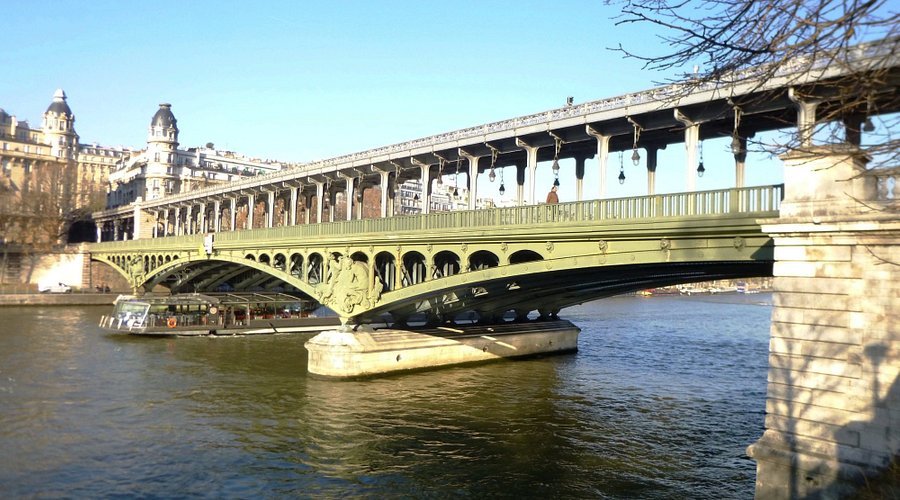
For a picturesque and easily accessible viewpoint, the Pont de Bir-Hakeim bridge offers a fantastic view of the Eiffel Tower, particularly at sunrise or sunset. It is also a favorite spot for photographers looking to capture a dreamy Parisian scene.
A Bridge Steeped in History
Originally known as the Pont de Passy, the bridge was renamed Pont de Bir-Hakeim in 1948 in honor of the Free French forces’ victory at the Battle of Bir Hakeim during World War II. This renaming reflects France’s enduring spirit and resilience, adding a deeper historical dimension to the bridge’s significance.
Completed in 1905, the bridge was designed by engineer Jean Résal and architect Louis Biette. Its striking two-level structure, combining metal and stone elements, was a remarkable feat of engineering at the time and remains an enduring icon of Parisian infrastructure.
Architectural Grandeur
Pont de Bir-Hakeim is unique among Parisian bridges due to its dual-deck design:
- The upper level supports the Paris Métro Line 6, one of the most scenic metro routes in the city, offering passengers a breathtaking view of the Seine and the Eiffel Tower as they cross the bridge.
- The lower level accommodates both pedestrians and vehicles, making it a favorite for walkers, cyclists, and photographers alike.
A defining feature of the bridge is its ornate metal columns, decorated with exquisite Art Nouveau-style details and sculptures by Gustave Michel, which add to its elegant aesthetic. These grand pillars not only support the upper deck but also create a mesmerizing visual rhythm that enhances the bridge’s cinematic appeal.
A Cinematic and Photographic Icon
Pont de Bir-Hakeim has gained worldwide recognition as one of the most filmed and photographed locations in Paris. It has been featured in numerous movies, including Christopher Nolan’s Inception (2010), where it served as the backdrop for one of the film’s most famous dream sequences.
For photographers and Instagram enthusiasts, the bridge offers an unparalleled perspective of the Eiffel Tower, especially at sunrise and sunset, when the lighting creates a magical atmosphere.
A Favorite Spot for Locals and Visitors
Beyond its cinematic fame, Pont de Bir-Hakeim is a favorite spot for both locals and visitors seeking:
- A Scenic Walk: Strolling across the bridge provides a peaceful yet awe-inspiring experience, with the Seine River flowing beneath and the Eiffel Tower towering in the background.
- Cycling Routes: The bridge is part of many popular cycling paths, offering riders a smooth and picturesque route through the city.
- Romantic Moments: Its enchanting views make it an ideal location for couples looking to capture unforgettable memories in Paris.
Best Time to Visit
The Pont de Bir-Hakeim is accessible year-round, but the best times to visit are:
- Early morning, for a quiet, serene atmosphere and soft lighting perfect for photography.
- Sunset, when the golden hues illuminate the Eiffel Tower and reflect beautifully on the Seine.
- Evening, when the bridge lights up, and the Eiffel Tower’s sparkling display adds a magical touch.
Interesting Facts About Pont de Bir-Hakeim
- It was one of the first bridges in Paris to be constructed primarily in metal, reflecting the industrial advancements of the early 20th century.
- The bridge connects the 15th and 16th arrondissements, linking the lively area of Passy with the famous Île aux Cygnes, home to the Statue of Liberty replica.
- The bridge's unique Art Nouveau-style details and symmetrical design make it one of the most recognizable bridges in the world.

